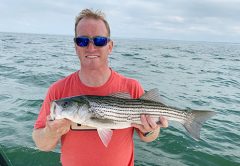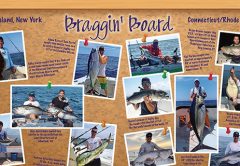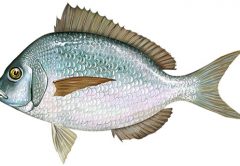
While the most serious of anglers tend to specialize in catching one species of game fish or another, many others consider themselves to be “generalist” when it comes to piscatorial pursuit. True, the chase for cow stripers, giant tuna or even doormat fluke provides unmatched challenge and reward, but there is still something very enjoyable about the relaxing and simplistic nature of mixed-bag bottom action in local bays and harbors.
With comfortable temperatures and plenty of summer-run fish already awaiting your offerings, July is the time to head on out and to see what you might pull up just a short ride from port. The variety pack includes a shot at kingfish, porgies, sea bass, blowfish, school weaks, harbor blues, triggerfish, blue claw crabs and more, all of which can be caught together using the same basic baits and techniques. And don’t be surprised if you do happen to bump into a sharpie or two while sending your baits to the bottom in quiet waters slightly off the beaten track – even the most ardent sport fishing fanatics need a breather from the high-octane routine now and then.

While you’ll surely be tossing back most of what you catch on mixed-bag inshore excursions, the odds are you’ll also bring home more than enough keepers to feed the family by the time the day is over. Even better, since the action is available on almost any moving tidal stage – with an edge generally to the top of the flood – you can fish when you have time without the need of waking up at dawn. Take the kids, too, because mixed-bag action is perfectly suited to building the enthusiasm and confidence of budding anglers.
BACK BAYS ARE PRODUCTIVE
Deep water is the key to finding where these mixed-bag species like to school – but keep in mind that “deep” is a relative term. If you can find a 20-foot deep hole in an area where the depth is mostly uniform ten to 15 feet deep, you’ve got a great place to anchor up and get started. If not, look for depressions that provide at least 10 to 12 feet of depth in channels that border large, sandy flats. The main east/west channel in any of our South Shore bays is a good spot to begin prospecting. Simply locate the deepest pocket or drop-off along the edge and set up there. Another good option is to position yourself at the edge of the main channel 1/4-to 1/2-mile in front of where a major tidal creek or river empties into the bay.
While the tendency is to think that the best bay catches are always made close to the inlets, that’s not necessarily the case with mixed bag fishing. On Great South Bay, for example, the Sore Thumb area near the mouth of Fire Island Inlet has long been recognized as a top spot for varied catches but good scores can also be made at buoys 12, 13, 20, 29 and 32, the flats off Barrett Beach, West Channel, Dickerson’s Channel, in the main channel between the Coast Guard Station and Ocean Beach, and in the western part of the bay at Copiague Hole and in the State Channel around Hemlock Cove. On Moriches Bay, you’ll find some interesting action in the deep hole off Westhampton in the eastern end of the bay, right in front of the Coast Guard Station, around buoy 15, and up west in the deeper portions of the main channel approaching Smiths Point Bridge.

Even between the forks in Peconic Bay action can be found far back from where most anglers concentrate their efforts. The southeast corner of Robbins Island is well known as a mixed-bag hot spot in these waters, but anglers willing to poke around a little bit can have the fish all to themselves at the southwest end of the island near Robins Rock, or across the bay at North Race, outside Cutchogue Harbor, and deep inside Southold Bay where Cory and Richmond creeks drain out into 12-to 20-foot depths. Similar spots can be found in Shinnecock and Jamaica bays if you break out the charts and look to see where good drainage intersects deep water along the major channel edges. If you are not sure where to start, ask the crew at your local tackle shop when you go to pick up bait. They’ll fill you in on the most ecent hot spots.
GO LIGHT, HAVE FUN
Considering the nature of these trips, it’s a good idea to keep your tackle a little on the light side. Lightweight fluke setups, conventional freshwater bass outfits and 10-to 12-pound class spinning gear are ideal for this kind of fishing because they allow your quarry to give a decent account of itself but still have backbone enough to handle the occasional 2-pound porgy, 4-pound fluke or 6-pound weakfish that might can inhale your bait.

In terms of rigging, a high-low bottom setup sporting a pair of size four or size two beak-style bait-holder hooks and a two-ounce bank sinker is the standard. This rig will allow you to present baits right on the bottom and a foot or two above. The gold colored hooks – standard porgy hooks – will stick just about any fish around and hold baits securely in place. I usually start with a size four. If I’m catching larger fish, I might move up to a size two to discourage smaller fish from getting hooked.
As for bait, it’s a good idea to carry at least two kinds when trying for a mixed-bag catch. Use a clam strip or three-inch long piece of sandworm on the bottom point and a long, thin pennant of squid on the top. The clam or worm bait is intended for porgies, blowfish, sea bass, kingfish and the occasional passing school weak. The squid strip is used to draw the attention of school weaks, passing blues, fluke and any of the bottom feeders that feel inclined to lift their heads. It’s amazing how both hooks can catch almost any species.
CHUM, CHUM, CHUM!
Two essentials you won’t want to be without when mixed-bag fishing are a chum pot and a landing net. The chum pot is an especially important tool. While it is true that porgies and sea bass are generally school fish, a pot full of crushed mussel or ground clam seems to tighten them into hungry, competitive packs. Other species, such as kingfish or weaks, travel alone or in small groups most of the time. Fish without chum and you’ll pull a few of these each season. Fish with chum and you’ll likely pick a few each trip.

As for the landing net, I’ve had eight-and ten-pound weaks, three-pound kingfish, chopper blues and fluke to seven pounds jump on my mixed bag baits. With the relatively small hooks that must be used to accommodate the smaller game, bringing along a net can be the difference between getting a lunker in the boat and watching it swim away – especially with the summer flatties and weakfish, both strong possibilities from late July through September.
[easy-social-share]









